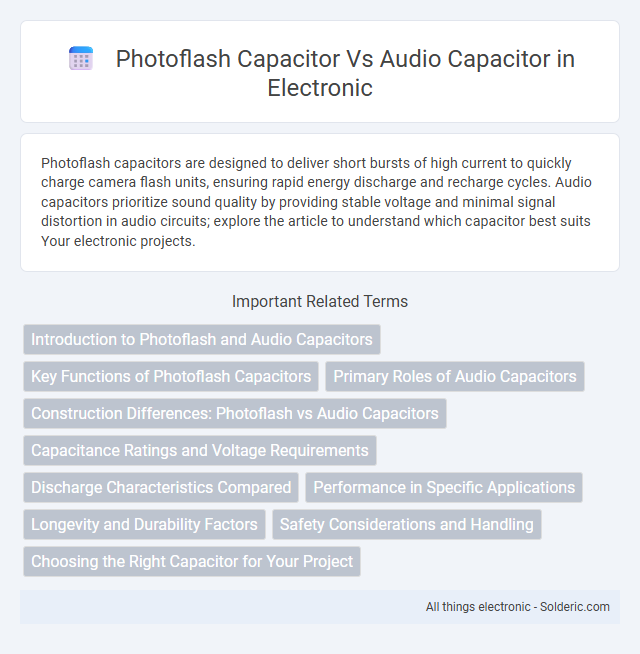Photoflash capacitors are designed to deliver short bursts of high current to quickly charge camera flash units, ensuring rapid energy discharge and recharge cycles. Audio capacitors prioritize sound quality by providing stable voltage and minimal signal distortion in audio circuits; explore the article to understand which capacitor best suits Your electronic projects.
Comparison Table
| Feature | Photoflash Capacitor | Audio Capacitor |
|---|---|---|
| Primary Use | High-speed discharge in camera flashes | Signal coupling, filtering in audio circuits |
| Capacitance Range | Typically 10uF to 100uF | Typically 0.01uF to 100uF |
| Voltage Rating | High voltage (up to 400V or more) | Moderate voltage (usually less than 100V) |
| ESR (Equivalent Series Resistance) | Low ESR for rapid discharge | Optimized ESR for minimal audio distortion |
| Discharge Rate | Fast, high-current discharge | Slow discharge, signal integrity priority |
| Construction | Designed for pulse applications | Designed for audio frequency stability |
| Typical Materials | Aluminum electrolytic | Electrolytic, film, or ceramic types |
| Durability | Robust for repetitive high-current pulses | Stable over long durations with minimal signal loss |
Introduction to Photoflash and Audio Capacitors
Photoflash capacitors are designed to deliver high voltage and rapid energy discharge essential for camera flashes, whereas audio capacitors prioritize stable signal filtering and low distortion in sound systems. The distinctive dielectric materials and construction methods optimize photoflash capacitors for brief, high-current pulses, while audio capacitors emphasize consistency and low noise for audio clarity. Understanding these differences helps you select the right capacitor type tailored to your electronic application's performance requirements.
Key Functions of Photoflash Capacitors
Photoflash capacitors are designed for rapid energy discharge to generate intense bursts of light, making them essential in camera flash circuits and strobe lights. Their key functions include storing high voltage and delivering quick, high current pulses to trigger the flash tube efficiently. Unlike audio capacitors, which prioritize frequency response and signal clarity, photoflash capacitors emphasize high capacitance and low equivalent series resistance (ESR) for fast, reliable energy release.
Primary Roles of Audio Capacitors
Audio capacitors primarily manage signal clarity and frequency response by filtering out noise and stabilizing voltage in audio circuits. They store and release energy to smooth out fluctuations, ensuring consistent sound quality without distortion or interference. Your audio devices rely on these capacitors to maintain clean and accurate audio output, unlike photoflash capacitors that are designed for high-voltage, short-duration energy bursts.
Construction Differences: Photoflash vs Audio Capacitors
Photoflash capacitors are designed with high capacitance and voltage ratings to deliver quick bursts of energy, typically constructed using electrolytic materials with robust, heat-resistant casings for rapid discharge. Audio capacitors prioritize low equivalent series resistance (ESR) and minimal distortion, often employing film or polypropylene dielectrics to maintain signal fidelity during amplification. Understanding these construction differences ensures you select the right capacitor type for applications demanding either high-energy pulses or precise audio performance.
Capacitance Ratings and Voltage Requirements
Photoflash capacitors typically have capacitance ratings ranging from 10uF to 500uF with voltage ratings between 200V and 450V, designed to deliver rapid bursts of high current necessary for camera flash circuits. Audio capacitors, in contrast, usually feature lower voltage ratings around 50V to 100V and capacitance values from 0.1uF to several hundred microfarads, optimized to handle audio signal filtering and coupling with minimal distortion. The distinct voltage requirements highlight photoflash capacitors' need to withstand high voltage spikes, whereas audio capacitors prioritize stable capacitance and low ESR for sound clarity.
Discharge Characteristics Compared
Photoflash capacitors exhibit rapid discharge characteristics designed to release high bursts of energy, enabling intense, short-duration flashes of light. Audio capacitors, optimized for steady signal filtering and coupling in audio circuits, demonstrate slower discharge rates with minimal energy spikes to maintain audio signal integrity. The key difference lies in photoflash capacitors' high capacitance and low equivalent series resistance (ESR), which facilitate quick energy release, whereas audio capacitors prioritize low leakage current and smooth discharge for consistent sound quality.
Performance in Specific Applications
Photoflash capacitors are designed for high-voltage, quick-discharge applications such as camera flashes, delivering rapid bursts of energy with low equivalent series resistance (ESR) to ensure fast, reliable performance. Audio capacitors prioritize low distortion and stable frequency response, optimized for signal filtering and coupling in audio equipment to maintain sound fidelity. Choosing the right capacitor depends on your application needs, as photoflash capacitors excel in pulse power scenarios while audio capacitors are tailored for continuous signal processing.
Longevity and Durability Factors
Photoflash capacitors are designed with high tolerance to rapid charge and discharge cycles, resulting in superior longevity under high-voltage pulse conditions compared to audio capacitors. Audio capacitors prioritize low distortion and signal integrity but often have thinner dielectric layers, which can reduce durability and lifespan under stress. Materials like metallized polypropylene in photoflash capacitors enhance their ability to withstand voltage spikes, whereas audio capacitors commonly utilize electrolytic materials that may degrade faster over time.
Safety Considerations and Handling
Photoflash capacitors are designed to store high voltage and discharge rapidly, making safety precautions critical to avoid electric shock or capacitor explosion; proper insulation, discharge before handling, and use of protective gear are essential. Audio capacitors operate at lower voltages but still require cautious handling to prevent damage to audio equipment or circuit malfunction, ensuring correct polarity and voltage ratings are maintained. Both types necessitate adherence to manufacturer guidelines and safe storage conditions to mitigate risks and ensure longevity.
Choosing the Right Capacitor for Your Project
Photoflash capacitors are designed for high-voltage, short-duration discharge applications, making them ideal for camera flash circuits requiring rapid energy release. Audio capacitors, especially film or electrolytic types, prioritize stable capacitance and low distortion to preserve signal integrity in audio frequency ranges. Selecting the right capacitor depends on evaluating voltage ratings, capacitance stability, and intended circuit function to ensure optimal performance and reliability in your project.
photoflash capacitor vs audio capacitor Infographic

 solderic.com
solderic.com